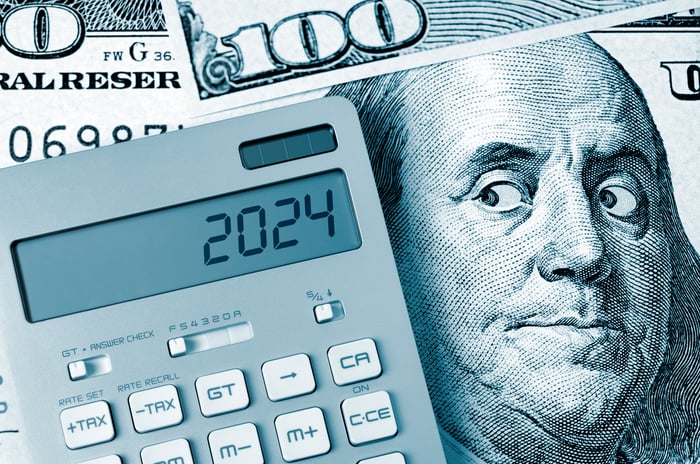It's been nothing short of a phenomenal year for optimistic investors, especially those who placed their faith (and dollars) into the "Magnificent Seven" stocks. As of the closing bell on Dec. 13, the S&P 500 and Nasdaq Composite were higher by 23% and 41%, respectively.
But it's not about where Wall Street has been; it's about where equities will head next.
Despite a handful of money-based metrics and predictive indicators suggesting Wall Street and the U.S. economy could face sizable challenges in the new year, I remain optimistic as a long-term investor. All 47 positions in my portfolio (as of the time of this writing) were made with the belief that the underlying stock (or option) would increase in value over time.
However, these nearly four-dozen positions aren't weighted equally. My top five holdings account for 54% of my currently invested assets, and they're the companies I'll be counting on to deliver for me in 2024, and likely well beyond.

Image source: Getty Images.
SSR Mining
Although the broad-market indexes have been humming along in 2023, it's been a rough year for precious-metal mining stocks. Soaring Treasury yields have made bonds a potentially more attractive safe-haven investment than gold, which has weighed on miners.
The issue more specific to my largest holding, SSR Mining (SSRM 0.91%), is that it announced plans to ramp up spending in the coming year in order to expand its annual gold-equivalent output beginning in 2026 and beyond.
In other words, higher costs and weaker production are expected in 2024 and potentially in 2025, with a significantly more favorable production profile and life-of-mine forecast in 2026 (and many years thereafter). Investors certainly weren't thrilled with the idea that annual production could decline by 10% until these projects are completed.
However, I'm not too concerned about SSR Mining's very near-term operating performance given its already-reduced share price. Management has historically been conservative with its guidance and production expansion. The company has also been off-loading noncore assets in an effort to boost its already impressive net-cash position.
Furthermore, SSR Mining is a cash-flow machine. Its board instituted a quarterly dividend in 2021 (my annual yield to cost is 20.2%) and has not been shy about authorizing share repurchases.
Most importantly, the stock is a screaming value. I view traditional gold mining stocks as fairly valued when they reach a multiple of 10 times operating cash flow. SSR Mining is on track to deliver north of $2 in cash flow per share this year, and $1.95 to $1.99 per share over the coming two years. Its shares are currently trading at a multiple to forward-year cash flow of a little over 5.
Teva Pharmaceutical Industries
I love a good turnaround story, which is why brand-name and generic-drug developer Teva Pharmaceutical Industries (TEVA 4.23%) clocks in as my second-largest holding for 2024.
Teva has had no shortage of issues over the past seven years. It grossly overpaid for generic-drug developer Actavis, which drove up its outstanding debt. It has also faced a myriad of legal issues, including litigation over its role in the opioid crisis, as well as alleged price-fixing with select generic therapies.
But what's been impressive is watching Teva successfully navigate these challenges and put them into the back seat. In July, Teva agreed to a $4.25 billion settlement to be spread over 13 years for outstanding opioid litigation.
There's also been meaningful progress with its balance sheet. Shortly after the Actavis deal, the company had about $35 billion in net debt. As of Sept. 30, Teva had reduced its net debt to $17.7 billion. The company has reduced its annual operating expenses by billions of dollars, as well as selling off noncore assets. It has more financial flexibility now than it has had in years.
Teva also intends to focus more of its efforts on developing brand-name drugs. Novel therapies have shorter exclusivity periods, but the operating margin and pricing power for brand-name drugs is significantly higher than for generics. The expectation is that this added investment in novel therapies will lift Teva's sales and profit growth in the years to come.
With a forward price-to-earnings (P/E) ratio of 4, Teva is the definition of "dirt cheap."

Image source: Getty Images.
Meta Platforms
The third-largest portfolio holding that I'll be counting on to make me richer in 2024 and beyond is social media stock Meta Platforms (META 0.43%). Meta stock has had a banner year, with shares up 178%, as of Dec. 13.
The biggest concern skeptics have for Meta is growing losses associated with its Reality Labs, which is Meta's virtual and augmented reality segment. It has lost nearly $11.5 billion through the first nine months of 2023, which is $2 billion more than it lost in the comparable operating period in 2022. It's not yet clear if investments in the metaverse and augmented/virtual reality are going to pay off.
What is clear is that Meta's social media assets are at the head of the class. Facebook is the most-visited social media app, while Instagram, WhatsApp, and Facebook Messenger are some of the most consistently downloaded apps worldwide. During the third quarter, Meta attracted just shy of 4 billion monthly active users (MAUs), which equates to more than half of the world's adult population. Advertisers are willing to pay a premium to reach this many eyeballs.
I'm also not overly concerned with Reality Labs' ongoing losses. The reason? Meta closed out September with more than $61 billion in cash, cash equivalents, and marketable securities, and it has generated $51.7 billion in net cash from operations through the first nine months of 2023. It can afford to take risks in order to position itself as a future leader in the metaverse.
To keep with the theme, Meta remains inexpensive. Despite more than doubling from their 2022 bear market low, shares can be purchased for just 11 times forward-year cash flow. That compares to an average multiple to year-end cash flow of 15.6 over the previous five years.
Lovesac
My fourth-biggest holding entering 2024 is small-cap furniture retailer Lovesac (LOVE -0.05%).
Lovesac's stock has retraced as much as 85% from its all-time high, set in 2021. Although valuation and investor sentiment during the 2022 bear market played a role in this downturn, the primary concern has been the fear of a recession. The furniture industry is highly cyclical, with recessions almost always leading to lower consumer spending.
But among small-cap stocks, there's probably not one I'm more confident can make me richer than Lovesac can. That's because it brings easily identifiable competitive advantages to the table.
Its furniture is its most front-and-center differentiator. Just shy of 90% of its net sales derive from "sactionals" -- i.e., modular couches that can be rearranged dozens of ways to fit most living spaces.
Sactionals have over 200 different cover choices, they come with an assortment of upgrade options, and the yarn used in their production is made from recycled plastic water bottles. There is no other product that comes close to the functionality, optionality, or eco-friendliness of sactionals.
Another reason Lovesac can succeed is its omnichannel sales platform. Though it does have physical stores in most states, it also relies on direct-to-consumer sales, pop-up showrooms, and partnerships with major chain stores and warehouse clubs to sell its furniture and increase brand awareness. Having less of a reliance on brick-and-mortar locations than traditional furniture retailers has led to lower overhead expenses and higher margins.
Stop me if you've heard this before, but Lovesac is cheap. A forward P/E of less than 13 for an industry game-changer growing by a double-digit percentage is an outright bargain.
The fifth-largest holding that I'm counting on to make me richer in 2024, and hopefully for many years thereafter, is social media platform Pinterest (PINS 4.04%).
Similar to Lovesac, a combination of valuation, the 2022 bear market, and the expectation of U.S. economic weakness eventually drove Pinterest's stock down by more than 80% from its record closing high. The company generates most of its revenue from advertising, and advertisers are often quick to pare back their spending at the first hint of trouble with the U.S. and/or global economy.
But this is a two-sided, and highly disproportionate, coin. Even though recessions are a normal and inevitable part of the economic cycle, they don't stick around for very long. All 12 recessions after World War II have lasted between two and 18 months. By comparison, most economic expansions are measured in years. This means ad-driven businesses like Pinterest often thrive over long periods.
What's been particularly noteworthy is its ability to monetize its MAUs. Despite a slowdown in average revenue per user (ARPU) in 2023, global ARPU jumped 10% in 2022 (i.e., during a bear market!) Pinterest is closing in on a half-billion MAUs, and advertisers have demonstrated a willingness to pay a premium to get their message in front of Pinterest's motivated shoppers.
Lastly, Pinterest's platform is largely insulated from changes made by app developers -- e.g., allowing users to decide whether or not they want companies tracking their actions and choices. Pinterest's entire operating model is based on its MAUs freely sharing the things, services, and places that interest them. This is data that can be served to advertisers on a silver platter, regardless of what happens with app developers and data-tracking software.
Pinterest's earnings are expected to grow by an annual average of 39% over the next five years, making its forward P/E of 28 an absolute steal.





